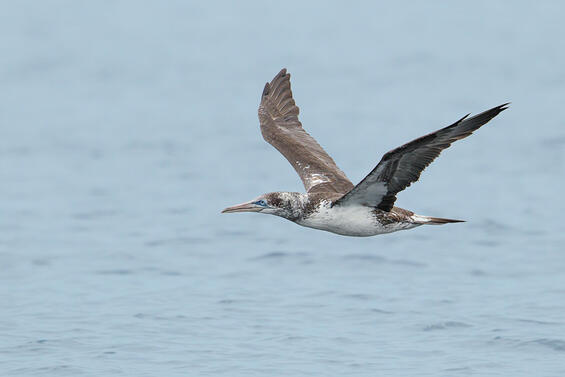- Scientific name: Morus bassanus
Species of Greatest Conservation Need (MA State Wildlife Action Plan)
Description
The northern gannet is an easily recognizable species with a white body, a yellowish-buff crown, black wingtips, and silvery beak. Juveniles have a dark plumage; their plumage becomes a mix of light and dark markings until they reach their mature adult plumage at 3 years or more of age. Gannets have a dramatic foraging technique that involves diving straight down, plunging into the water in search of their fish prey. The northern gannet is the largest North Atlantic-breeding seabird.

Northern gannet (Morus bassanus)
Life cycle and behavior
The breeding phenology of northern gannets varies individually, annually, and among colonies throughout their range. Spring migration towards the breeding colonies begins in February, with breeders arriving around March. Pairs lay a single one-egg clutch which is incubated for roughly 44 days by both sexes. At hatch, chicks are altricial with little motor coordination. Both adults feed chicks through partial regurgitation and chicks are attended by at least one parent throughout the chick-rearing period. Chicks fledge at about 90 days by jumping off cliff edges. Fledglings fly for at least 400 meters from the colony and then land in the sea. Fledglings cannot take off from water initially, so they must swim away from the colony. While it is unknown when fledglings are capable of at-sea flight, it is assumed to be about 1-2 weeks after colony departure. Colony departure begins in late September and most individuals immediately head south. Juveniles do not return to the colony for about three years and then spend an additional 2-3 years at the colony as non-breeding immatures. Typical age at first breeding is 5-6 years. Northern gannets lifespans are at least 21 years and interannual adult survival is high.
Northern gannets’ primary foraging technique is plunge-diving. They dive from a height of 10–40 meters and plunge vertically into the water column. Dive depths are variable but can reach up to 20 meters below the surface, where gannets can then use their wings and feet to swim another 10 meters deeper. Northern gannets are generalists and consume a variety of surface schooling fish and squid.
Population status
Northern gannets are estimated at 1,500,000–1,800,000 mature individuals and both the North American and European populations have increasing populations trends.
Distribution and abundance
Northern gannets are found south of the Arctic to the sub-tropics over continental shelves. They form large aggregations where food is plentiful and breed on densely packed colonies. Their established colonies are in eastern Canada, Iceland, the Faroe Islands, Ireland, the United Kingdom, France, and Norway.
Habitat
Northern gannets breed on inaccessible stacks, islands or coastal cliffs in the North Atlantic. Northern gannets are found throughout cold, temperate waters over continental shelves and typical avoid deeper water. They can be seen off the coast of Massachusetts outside of the breeding season.
Healthy habitats are vital for supporting native wildlife and plants. Explore habitats and learn about conservation and restoration in Massachusetts.
Threats
Northern gannets are heavily impacted by fishery bycatch and are particularly associated with demersal longline operations. Through their trophic status, organochlorides and metals tend to accumulate higher in gannets than other seabirds. While it’s unclear how metal and organochloride contaminants impact individuals, the banning of DDT and limiting of PCBs are correlated with increased reproductive success at Northwest Atlantic colonies. Gannets are identified as higher risk for collision with offshore wind farms, but thus far impacts are limited. Gannets are likely impacted by plastic pollution. There are small, traditional harvesting efforts in Europe, but overall impacts from human harvesting are limited.
In 2021 and 2022, northern gannets throughout their range were heavily impacted by an outbreak of High Pathogenicity Avian Influenza (HPAI). Many colonies reported unusually high mortality, decreases in occupied nest-sites, and reduced reproductive success, and HPAI was confirmed at most of the affected sites. Although researchers have yet to determine the exact extent of direct HPAI mortality, it is believed that HPAI is largely responsible.
Plastic trash in the environment poses a threat as it can be mistaken as food by seabirds and shorebirds and ingested or cause entanglement. Ingested plastics, common for seabirds, can block digestive tracts, cause internal injuries, disrupt the endocrine system, and lead to death. Entanglement from fishing gear and other string-like plastics can cause mortality by strangulation and impairing movements.
Conservation
Much of the population breeds at protected sites, which reduces human disturbance and has likely positively contributed to the northern gannet’s population growth. Future research is needed on much of the Northern Gannet’s non-breeding ecology. This includes prey sources, sources of mortality, migration routes, and colony dispersal. At the colony, future studies are needed to determine annual survival, the presence of contaminants, and the distribution and abundance of important prey species. Lastly, further research and monitoring is needed to determine the ongoing effects and demographic consequences of the most recent HPAI outbreak.
Avoid or recycle single-use plastics and promote and participate in beach cleanup efforts.
References
BirdLife International. “Species factsheet: northern gannet Morus bassanus.” 2018. Birdlife International. https://datazone.birdlife.org/species/factsheet/northern-gannet-morus-bassanus
Enticott, J., and D. Tipling. Seabirds of the World. Mechanicsburg, PA: Stackpole Books, 1997.
Lane, et al. “High pathogenicity avian influenza (H5N1) in northern gannets (Morus bassanus): Global spread, clinical signs and demographic consequences.” 2024. Ibis 166(2): pp 633-650.
Mowbray, T. B. “northern gannet (Morus bassanus), version 1.0. In Birds of the World (S. M. Billerman, Editor)”. 2020. Cornell Lab of Ornithology, Ithaca, NY, USA. https://doi-org.silk.library.umass.edu/10.2173/bow.norgan.01
Contact
| Date published: | May 15, 2025 |
|---|